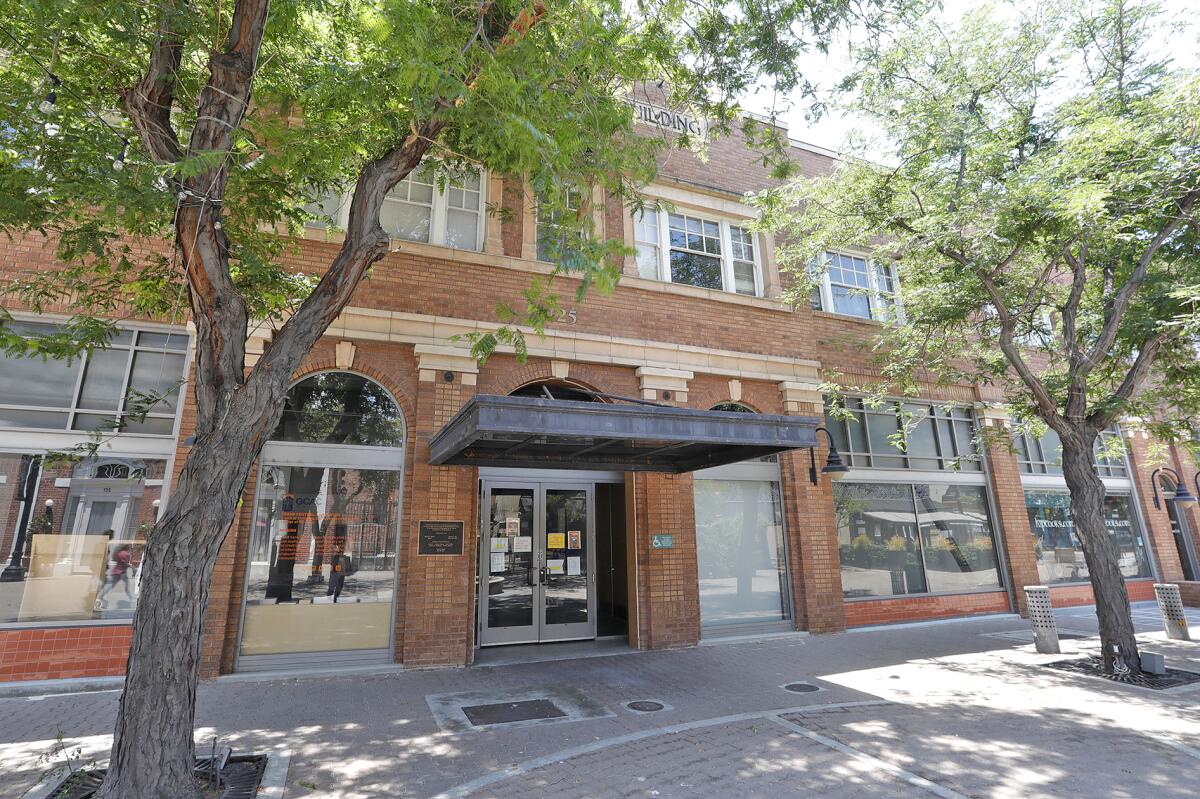Santa Ana Artists Village founder Don Cribb passes away at 77

Miguel Pulido recalled when Don Cribb stopped by Ace Muffler Shop in 1987 to discuss a vision for a new arts colony in Santa Ana.
Between invoices, customer calls, and muffler repairs, Cribb rolled blueprints over a desk at Pulido’s family business. He had formed the Santa Ana Council of Arts and Culture that same year and believed such a colony could go a long way toward overhauling the city’s reputation for gangs, poverty and crime.
Pulido, an upstart politician serving his first term on Santa Ana City Council, listened attentively to Cribb’s impassioned pitches.
“We would start talking about what was possible,” said Pulido, who later served as Santa Ana’s mayor from 1994 to 2020. “I credit Don with developing much of the concept of an artists village in downtown Santa Ana. Many others worked on it, but Don was an early visionary.”
Cribb lived to see the Santa Ana Artists Village take shape with dozens of studios, galleries, restaurants and cafes dotting the 10-block area after the city first committed to the project in 1994 by purchasing the future site of the Grand Central Art Center.
But, according to the Orange County Coroner’s office, the former planning commissioner and arts advocate passed away at 77 on Sept. 4 in Santa Ana, one month shy of the Artist Village’s 30th anniversary.
Cribb left behind a legacy that has been celebrated by backers as key to revitalizing downtown while critics decried it as “artwashing” gentrification in Santa Ana, a majority Latino city.

Born in New Bern, North Carolina, Cribb first moved to Orange County with his family in 1950. Cribb’s father, a Korean War veteran, transferred to El Toro Marine Base. The Cribbs later settled in Santa Ana.
In his early 20s, Cribb gallivanted from Los Angeles to New York to London and rubbed elbows with artists like Andy Warhol and David Hockney. He wanted his hometown to have an outsized arts reputation and served as president of the arts and culture council he founded to make that ambition come to life.
Cribb conceptualized a vibrant arts colony as a rebellion against the beige “blandscape” of Orange County suburbia.
It’s a vision that was initially ignored until Hockney, a personal friend who painted a portrait of Cribb, did a solo exhibit in Santa Ana instead of Newport Beach.
Santa Ana followed by purchasing an abandoned brick building in 1994 that Cribb long eyed as the Artists Village’s cornerstone. The city invested $7.2 million over several years in transforming the property into the Grand Central Art Center, a Cal State Fullerton annex where art students lived and worked once it opened five years later.
Community block grants also helped rehab a former auto shop nearby into the new home for the Orange County Center for Contemporary Art, which opened in 2000.
“Don was an urban planning genius,” said Jeffery Frisch, OCCCA’s executive director and the first artist to move into the village. “He not only knew about the arts, but he also knew about what kind of economic mix it took for an area to survive and thrive.”
Cribb had the Chiarini Fountain that serves as the landmark for the 2nd Street Promenade donated. “First Saturday” artwalks drew throngs of people to the area’s restaurants, cafés and exhibits.
Media outlets hailed Santa Ana’s new reputation. The Los Angeles Times profiled Cribb in 2001 as the man behind the metamorphosis, which was backed by $11 million in city spending.
“I’d gone out and had all these adventures in the art scene in Los Angeles and New York and saw how much artists contribute to a community. I wanted to bring it back and share it with my hometown,” Cribb told The Times. “I thought there was only one opportunity left — the golden plum — to save the town from irrelevance.”

The notion that Santa Ana needed to be rescued in such words has long irked critics.
Sarah Rafael Garcia, an author, artist and founder of Crear Studio in downtown Santa Ana, took offense to Cribb’s past comments calling downtown a “grease pole to hell” before the Artists Village emerged.
“Cribb has become a white savior figure in this revamped history,” Garcia said. “It’s masked with an Italian marble fountain in the Artists Village that is considered a landmark but serves to erase the harm caused to local residents.”
More than just rehabbing gutted buildings, Cribb’s vision paved the way for working class residents to be displaced from downtown as new lofts opened. After buying one complex near the Artists Village, a developer offered one month’s rent to remaining residents to move out in favor of artists and higher-end tenants.
By 2004, artists found themselves complaining about being priced out as landlords raised rents. Cribb, then a planning commissioner, said at the time that the city sometimes gets in its own way.
Some local Latino artists and impresarios felt in the way and overlooked in their own hometown.
Sali Heraldez founded SolArt Gallery & Café in 2004, which housed alternative art exhibits and concerts by local musicians away from the hub of the Artists Village.
She wasn’t opposed to the idea of such a village but had a different concept of what arts in Santa Ana could mean.
“My idea of a community arts space was always to be as organic and representative of the community that I was a part of,” Heraldez said.
She recalled a handful of interactions with Cribb, including a time when he dismissed SolArt Gallery & Café as a space that wouldn’t attract “serious” artists like the Artists Village did.
After the gallery closed years later, Cribb objected to Heraldez organizing shows and exhibits at OCCCA. In 2012, she helped curate “Siempre es hoy,” a photography exhibit at the gallery that documented the Latin Alternative music scene. It packed OCCCA and felt like a vindication.
Garcia later became the first Chicana from Santa Ana to live and work at Grand Central Art Center as an artist in residence in 2016, a timespan she saw as telling of the arts district’s priorities. When Crear Studio began in the center’s basement, Garcia recalled being told by the director that the studio’s work didn’t meet the aesthetics for its walls.
Pulido expected Cribb’s vision to conjure up critics from the onset and tangled early on with former Santa Ana Councilman Ted Moreno over plans for the Artists Village. Moreno argued that the project would bring artists who were out of touch with the city’s Latino community.
But Pulido believes Latinos and the arts aren’t incompatible. For the retired politician, Santa Ana is better off for having had Cribb’s work and influence as an arts and civics leader.
He credits the Artists Village with helping to persuade the Orange County School of the Arts to relocate from Los Alamitos to Santa Ana, a move that he claimed the city’s own arts administrator at the time didn’t believe could happen.
Luxury housing planned along streetcar route sparks fears of displacement in Santa Ana’s Latino neighborhoods. Others welcome transit-oriented development.
Turning toward the future, as the OC Streetcar gets ready to board passengers next year, Pulido sees a growing and connected downtown as a still unfurling legacy of Cribb’s work, including the time he spent on the county’s light-rail advisory committee.
“The Artists Village linked the east and west of downtown,” he said. “Restaurants began to open up on the other side of Main Street and the Chase family, as developers, encouraged more art-related activities.”
Along the way, the Fiesta Marketplace that once catered to immigrant shoppers became a trendier East End amid continued anti-gentrification protests.
It’s a debate that isn’t likely to subside after Cribb’s passing.
Pulido sees change and its discontents as the offspring of a consequential life.
“For a guy that never officially entered politics, Don was very political,” he said. “He had a lot of influence.”
Updates
4:03 p.m. Sept. 19, 2024: Updated with a clarification on Sarah Rafael Garcia’s artist in residence at Grand Central Art Center in 2016.
All the latest on Orange County from Orange County.
Get our free TimesOC newsletter.
You may occasionally receive promotional content from the Daily Pilot.





